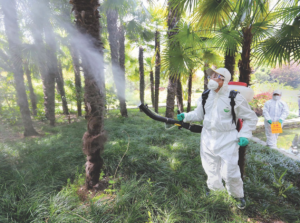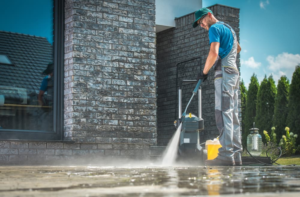Accurate identification is essential before attempting to control a pest. A well-watered, healthy plant may withstand some damage from a pest.
Biological, cultural, and physical controls kill or block pests or make the environment unsuitable for them. Examples include:
- Traps for rodents.
- Mulching to deny weed seeds the sunlight they need to germinate.
- Planting “trap” crops to lure pests away from harvest crops.
Visit Our Website to learn more.

Ideally, pests are prevented from entering or becoming problems in the first place. This requires an understanding of pest biology and behavior as well as environmental factors that favor their presence or abundance. These include soil conditions, water availability, plant health, and management practices. Many pests can be controlled without the use of chemical treatments, such as adjusting planting dates or selecting disease-resistant plants.
Pest prevention also includes sanitation measures to reduce the movement of pests between sites. This can be done by maintaining cleanliness in food handling areas, increasing garbage pickup frequency, and decontaminating equipment between uses. Sanitation practices may also be used to control pests that damage crops, such as using pest-free seeds or transplants and removing crop residue from fields after harvest.
When pest prevention is not possible, it is important to minimize harm from existing populations. This means controlling the number of pests to below levels that cause unacceptable economic or aesthetic injury, and doing so with minimal disruption of natural or human-modified ecosystems. It is often necessary to evaluate the economics of various control methods in order to make this decision.
Suppression and prevention are often mutually supportive objectives. Removing the habitat or food sources that support pests can allow them to quickly decrease in population size and damage to plants and structures. Cultural methods of pest suppression in agricultural settings include soil preparation and choosing plants that are adapted to site conditions and tolerant of insect or mite problems; interplanting; rotating crops; planting “trap” crops to lure insects; and managing weeds.
Chemical control strategies are sometimes used to complement preventive and sanitation measures, or as a last resort when other controls have been unsuccessful. These include physical, biological, and chemical controls (including Integrated Pest Management). It is important to evaluate the risks of each treatment option in light of the overall system into which it is being applied. If a pesticide is chosen, its application should be targeted to specific sites and done in a way that minimizes exposure of people, pets, and livestock to it.
Suppression
Pests are undesirable organisms that damage or degrade crops, landscapes, and human activities. They can include insects, fungi, viruses, nematodes, and vertebrates (birds, amphibians, reptiles, mammals) that disrupt the natural balance of species and that negatively affect soil health, food stores, gardens, lawns, crops, homes, and commercial and recreational sites. In addition, they can alter terrestrial and aquatic habitats by displacing native plant species, disrupting nutrient cycling, increasing fire frequency, reducing soil moisture levels, and changing the environment’s available energy and carbon resources.
Controlling pests is a challenge in all settings because they have many ways of adapting to new conditions and avoiding predators and competitors. However, it is possible to improve pest management by implementing preventive practices.
Preventive measures focus on denying pests the necessary elements to grow or reproduce, such as food, water, shelter, proper temperature, and space. This can be done by removing their breeding or feeding sites, such as repairing or covering holes in a structure’s walls, roof, or fences; disposing of waste materials in sealed containers; removing weeds regularly from landscaping and garden areas; and mulching around sun-loving plants to deny weed seeds the sunlight they require.
Certain natural features limit pest populations, such as mountains and large bodies of water, and weather conditions affect them directly or indirectly. Rain, freezing temperatures, drought, or overcast skies suppress insect activity, while excessive rainfall encourages them. The ability to overwinter in a protected place also limits some pests.
Biological controls – parasitic, predatory, or pathogenic organisms that attack or kill pests – can be used in conjunction with preventive measures to decrease the use of chemicals. Examples include parasitic wasps that lay eggs in the nests of caterpillars, nematodes that feed on rootworms, and bacteria such as Bacillus thuringiensis that produce toxins that destroy caterpillars’ midguts.
When using any type of control method, it is important to always read and follow the product label. Basic personal protective equipment includes long-sleeved shirts and pants, closed-toe shoes, face and eye protection, and gloves. Continual education through ongoing training helps to reduce risk and keep workers safe.
Eradication
Eradication of pests is rarely attempted in outdoor pest situations because it is much more difficult to achieve than prevention and suppression. However, it can be a desirable goal in enclosed environments such as dwellings; schools; office buildings; health care, food processing, and food preparation facilities; and other public areas. Eradication is also a common goal of some plant protection programs, such as those for Mediterranean fruit fly, gypsy moth, and fire ant.
Eradication of a pest population is not possible without adequate diagnosis, which in turn requires proper identification of the pest. Incorrect identification can lead to improper selection and application of control measures. For example, applying a pesticide that is not effective against the target species will fail to control the pest and may harm other plants or animals.
Incorrect diagnosis can also result in unnecessary use of pesticides, which is costly and environmentally irresponsible. A failure to properly follow label directions can also render a pesticide ineffective, as well as expose human beings and other organisms to potentially harmful chemicals.
Biological management relies on predators, parasitoids, and pathogens to reduce pest populations in the environment. These organisms naturally occur in nature and are often specific to the pest species they prey upon. Some examples include nematodes that kill or injure certain insects, fungi that cause disease in plants, and bacteria such as Bacillus thuringiensis that produce toxins that are deadly to caterpillars.
The effectiveness of these natural enemies can be enhanced by releasing more of the enemies into an area or by adding new ones that are not native to the location. There is usually a time lag between the increase in the number of natural enemies and the reduction in pest populations, but sufficient control can be achieved under most circumstances.
Purchased natural predators may be effective for only a short period of time. This is because many natural predators are able to travel long distances in search of prey. In addition, some predators have limited life spans or must eat frequently to survive. Therefore, they must be restocked or replaced periodically.
Monitoring
Pest monitoring is the regular searching for and identification of pests and the damage they cause. It is a critical component of IPM. Accurate pest identification is the first step in determining what methods to use for control. Without good identification, it is possible to apply inappropriate control practices that will not achieve desired outcomes or increase the risk of adverse effects on humans, plants and the environment.
Pests are organisms such as insects, bacteria, fungi, mites, nematodes, weeds, or vertebrate animals that negatively impact human activities or the environment. Pests can devalue agricultural crops, landscapes and lawns, displace native species and disrupt ecosystems that provide food, shelter, and other essential resources.
The goal of pest management is to prevent or limit the occurrence of pests at unacceptable levels. This may be based on esthetic, health, or economic considerations. The level at which pests become damaging is known as an action threshold. Thresholds can vary by location and pest. For example, homeowners might set a threshold at the number of millipedes or green June beetle grubs in their lawn. The action threshold is then used to guide decisions about when to apply predators or other controls.
Effective IPM strategies reduce the numbers of pests below action thresholds by combining different management techniques in a single plan. These include monitoring, scouting, cultural control, and biological or chemical (pesticide) controls.
Cultural or environmental factors can also help to control or limit pest populations. For instance, crop rotation, selecting disease-free rootstocks, or providing adequate water and fertilizer can reduce the attractiveness of an area to pests.
In addition, limiting the number of places where a pest can reproduce can reduce its population size and the damage it causes. This can be done by changing the habitat, reducing the availability of food or water, or by altering weather conditions that favor pests.
IPM programs try to avoid using pesticides when not necessary. The best way to do this is by accurately identifying the pest and understanding its biology and behavior. This includes recognizing the differences between continuous, or invasive, pests that need to be controlled on a regular basis and sporadic or migratory pests that can be controlled less frequently.

